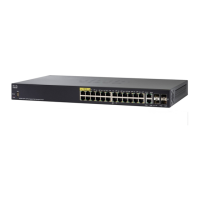SPAN and RSPAN Commands
Cisco Sx350 Ph. 2.2.5 Devices - Command Line Interface Reference Guide 1092
57
• interface
interface-id
—Specify the source interface for a SPAN or RSPAN
session (Ethernet port).
• both, rx, tx—Specify the traffic direction to monitor. If you do not specify a
traffic direction, the source interface sends both transmitted and received
traffic.
• vlan
vlan-id
—Specify the SPAN source interface as a VLAN ID. In this case
only a value of 1 is allowed for the
session_number
argument.
• remote vlan
vlan-id
—Specify the source RSPAN source VLAN ID. The VLAN
must be defined as a RSPAN transit VLAN in the source, intermediate and
final switches by the remote-span command.
Default Configuration
No SPAN and RSPAN sessions are configured.
Command Mode
Global Configuration mode
User Guidelines
Use the monitor session
session_number
source interface
interface-id
[both | rx |
tx] command, to create a SPAN or RSPAN start source session to monitor traffic
that enters or leaves a source port.
Use the monitor session
session_number
source vlan
vlan-id
command, to create
a SPAN or start RSPAN source session to monitor traffic that bridged into a source
VLAN.
Use the monitor session
session_number
source remote vlan
vlan-id
command, to
create a final RSPAN source session to monitor traffic that passed via a RSPAN
VLAN.
A SPAN or RSPAN session consists from up to 8 sources and one destination with
the same session number.
Each monitor session source command defines one source port or VLAN. Different
monitor session source commands must define different sources. A new
command with the same session number and the same source overrides the
previous defined one.
Up to 8
sources can be defined in one session.

